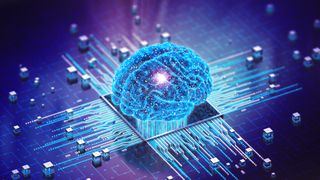In a 1st, scientists combine AI with a 'minibrain' to make hybrid computer
Researchers plugged a "brain organoid" into an artificial intelligence system, using the neural tissue to help complete computational tasks. The experiment could mark a step toward "biocomputers."

To boost the computing power of artificial intelligence (AI), researchers have combined run-of-the-mill machine learning with a sophisticated 3D model of the human brain made of different types of brain tissue grown in the lab.
These miniature models of the brain, known as cerebral organoids or "minibrains," have existed in various forms since 2013. But they've never been harnessed as a way to augment AI.
The new research uses more traditional computing hardware to input electrical data into the organoid and then decipher the organoid's activity to produce an output — so the organoid serves only as the "middle layer" of the computing process.
While the method is far from mimicking either the true structure of the brain or how it works, it may provide an early step toward creating biocomputers, which would borrow tricks from biology to make them more powerful and energy efficient than traditional computers. It could also lead to more insight into how the human brain operates and how it is affected by neurodegenerative conditions, such as Alzheimer's and Parkinson's disease.
For the new study, published Monday (Dec. 11) in the journal Nature Electronics, the researchers used a technique called reservoir computing; in this context, the organoid serves as the "reservoir." In such a system, the reservoir stores information and reacts to information that's inputted. An algorithm learns to recognize changes triggered in the reservoir by different inputs and then translates these changes as its outputs.
Using this framework, the researchers plugged the brain organoid into this system by supplying it with electrical inputs delivered through electrodes.
"Basically, we can encode the information — something like an image or audio information — into the temporal-spatial pattern of electrical stimulation," said study co-author Feng Guo, an associate professor of intelligent systems engineering at Indiana University Bloomington.
In other words, the organoid responds differently depending on the timing and spatial distribution of the electricity from the electrodes. The algorithm learned to interpret the organoid's electrical responses to that stimulation.
Although the brain organoid is much simpler than an actual brain — it's essentially a small sphere of brain cells — it has some ability to adapt and change in response to the stimulation. The response of the different types of brain cells, cells at different stages of development, and brain-like structures in the organoid provide a rough analog to the way our brains change in response to electrical signals. Such changes in the brain fuel our ability to learn.
Using this unconventional hardware, the researchers trained their hybrid algorithm to complete two types of tasks: one related to speech recognition and another to mathematics. In the former, the computer showed about 78% accuracy at recognizing Japanese vowel sounds from hundreds of audio samples. And it was fairly accurate in solving the math task but slightly less so than traditional types of machine learning.
The research marks the first time a brain organoid has been used with AI, but previous studies have used simpler types of lab-grown neural tissue in a similar way. For example, scientists have interwoven brain tissue with a form of reinforcement learning, a type of machine learning that might have more similarities with how humans and other animals learn than reservoir computing.
Future research could attempt to combine brain organoids with reinforcement learning, said Lena Smirnova, an assistant professor of environmental health and engineering at Johns Hopkins University who co-authored a commentary about the new study.
One of the advantages of creating biocomputers would be energy efficiency, since our brains use far less energy than today's advanced computing systems. But Smirnova said it might be decades before technology like this could be used to create a general-use biocomputer.
While organoids aren't close to replicating full-blown human brains, Smirnova hopes the technology will give scientists a better understanding of how the brain works, including in diseases like Alzheimer's. Replicating both the brain's structure (with organoids) and function (with computing) could allow researchers to better understand how the brain's structure is related to learning and cognition, for instance.
As with organoids in general, these computing systems could hopefully help replace drug testing in animals, Smirnova added, which both raises ethics issues and doesn't always yield useful results because animals differ so much from humans. Incorporating organoids derived from human brain tissue into drug testing could help close that gap.
Ever wonder why some people build muscle more easily than others or why freckles come out in the sun? Send us your questions about how the human body works to community@livescience.com with the subject line "Health Desk Q," and you may see your question answered on the website!
Sign up for the Live Science daily newsletter now
Get the world’s most fascinating discoveries delivered straight to your inbox.

Rebecca Sohn is a freelance science writer. She writes about a variety of science, health and environmental topics, and is particularly interested in how science impacts people's lives. She has been an intern at CalMatters and STAT, as well as a science fellow at Mashable. Rebecca, a native of the Boston area, studied English literature and minored in music at Skidmore College in Upstate New York and later studied science journalism at New York University.
-
DemonRaven Just because we can do something does not mean we should. Combining computers and AI with cells made from brains increases the risk of AI becoming self aware. Did anyone on the team bother to think through the ramifications of this experiment?Reply
Most Popular

By Ben Turner

By Ben Turner